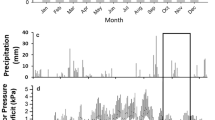Abstract
Our objective was to evaluate the relative importance of gradients in light intensity and the isotopic composition of atmospheric CO2 for variation in leaf carbon isotope ratios within a Pinus resinosa forest. In addition, we measured photosynthetic gas exchange and leaf carbon isotope ratios on four understory species (Dryopteris carthusiana, Epipactus helleborine, Hieracium floribundum, Rhamnus frangula), in order to estimate the consequence of the variation in the understory light microclimate for carbon gain in these plants. During midday, CO2 concentration was relatively constant at vertical positions ranging from 15 m to 3 m above ground. Only at positions below 3 m was CO2 concentration significantly elevated above that measured at 15 m. Based on the strong linear relationship between changes in CO2 concentration and δ13C values for air samples collected during a diurnal cycle, we calculated the expected vertical profile for the carbon isotope ratio of atmospheric CO2 within the forest. These calculations indicated that leaves at 3 m height and above were exposed to CO2 of approximately the same isotopic composition during daylight periods. There was no significant difference between the daily mean δ13C values at 15 m (–7.77‰) and 3 m (–7.89‰), but atmospheric CO2 was significantly depleted in 13C closer to the ground surface, with daily average δ13C values of –8.85‰ at 5 cm above ground. The light intensity gradient in the forest was substantial, with average photosynthetically active radiation (PAR) on the forest floor approximately 6% of that received at the top of the canopy. In contrast, there were only minor changes in air temperature, and so it is likely that the leaf-air vapour pressure difference was relatively constant from the top of the canopy to the forest floor. For red pine and elm tree samples, there was a significant correlation between leaf δ13C value and the height at which the leaf sample was collected. Leaf tissue sampled near the forest floor, on average, had lower δ13C values than samples collected near the top of the canopy. We suggest that the average light intensity gradient through the canopy was the major factor influencing vertical changes in tree leaf δ13C values. In addition, there was a wide range of variation (greater than 4‰) among the four understory plant species for average leaf δ13C values. Measurements of leaf gas exchange, under natural light conditions and with supplemental light, were used to estimate the influence of the light microclimate on the observed variation in leaf carbon isotope ratios in the understory plants. Our data suggest that one species, Epipactus helleborine, gained a substantial fraction of carbon during sunflecks.
Similar content being viewed by others
Author information
Authors and Affiliations
Additional information
Received: 21 March 1996 / Accepted: 13 August 1996
Rights and permissions
About this article
Cite this article
Berry, S., Varney, G. & Flanagan, L. Leaf δ13C in Pinus resinosa trees and understory plants: variation associated with light and CO2 gradients. Oecologia 109, 499–506 (1997). https://doi.org/10.1007/s004420050110
Issue Date:
DOI: https://doi.org/10.1007/s004420050110



